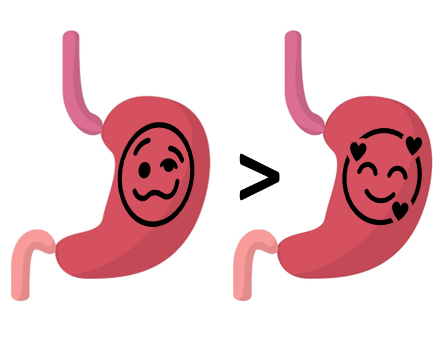Improving Gut Health Naturally While Living a Traveling Lifestyle
How does our gut health impact us?
I have had this ideal image of what getting health is. To me, it always seemed the epitome of health was working out and eating grilled chicken with salads for every meal. That is what we see on TV, so that must be correct. Right?
Well, it is not completely wrong, but there is so much more to health than that.
Take a moment and think of your family tree. What health problems run in your immediate family? We are talking your parents, your parent in-laws (if you have them), brothers, sisters, and children.
If you asked me this question, I would tell you: Multiple Sclerosis, Lupus, Cancer, Polycystic Ovarian Syndrome (PCOS), Endometriosis, Type 1 Diabetes, Type 2 Diabetes, Gastroesophageal Reflux Disease (GERD), High Blood Pressure, and History of Heart Attacks.
Now think about your grandparents and their grandparents, what health problems did they have?
If you asked me, History of Stroke, History of Heart Attack, Glaucoma, and Cancer.
What is the difference between these generations? What causes so many autoimmune health conditions now, when they did not experience that 60+ years ago?
The answer is gut health.
Most individuals think the job of our gastrointestinal tract is to take the sustenance we provide, break it down, absorb the nutrients, and discard the toxins.
However, our guts do more then that.
The gastrointestinal tract of an adult is approximately 30 feet long and in a healthy gut, you would find healthy bacteria and immune cells to combat bad bacteria, viruses, and fungi.
You would also find, our bodies “2nd brain” as it is referred to by some medical professionals. This brain in our gut does not control our ability to do normal everyday skills, like reading and writing, but it does contribute to our hormone levels, our moods, our mental health, and the overall functioning of our bodies.
Don’t believe me? Read here where John Hopkins Medicine discusses the link between our guts and brain, and how this connection can lead to anxiety or depression in individuals with bowel disorders.
Or here, where Harvard Health links our gut health and digestion with anxiety.
And if that still is not enough reasons to focus on our gut health first, check out this discovery made by researchers at the Mayo Clinic where they detected that an out-of-wack microbiome is associated with autoimmune diseases such as rheumatoid arthritis, multiple sclerosis (MS) and celiac disease.
If our health depends on our gut health, then how do we improve it?
The steps to healing our gut:
1: Processed Foods
If you read my previous post, you know that I am working on reducing processed foods in our diets. Gut health is one of the reasons I am doing that.
When foods are commercially processed, they usually contain preservatives that are meant to prevent the growth of bacteria on our foods.
So, if our food contains an agent that prevents bacteria growth, how does that affect our gut and all its healthy bacteria?
According to the University of Hawaii “The College research found that sulfites in food preservatives killed or inhibited the growth of the good bacteria when tested at levels generally regarded as safe by the FDA.”
Even though the evidence is overwhelming about the importance of gut health, some people are not willing to or do not know how to break away from the processed preservative filled foods that fill our diets.
I can tell you it is not hard to do so, but until you are ready to make that change, it will be hard for you to do so.
Just take it one step at a time.
Any reduction in these foods is better than you were doing.
Take something you have in your everyday life and learn to make it from scratch, and then once you are comfortable with that item, you do it again.
For me, that was bread. We love bread in our family but store bought white bread is not healthy for anyone. Did you know it is even bad for ducks?
So, I chose bread. I began researching it and learning the basics. Then, I began figuring out how to simply the process and make it work in my tiny RV kitchen.
Now, I have developed my own bread recipe and I make it for my family 2-3 times a week. The same recipe makes loaf bread, pizza dough, and dinner rolls. I will be releasing it soon, so stay tuned.
2: Reintroducing healthy gut bacteria while traveling
If you are like me, you may be feeling a little panicky after finding out all of this information. You knew processed foods weren’t the best for you, but for them to actually be damaging to your family’s health, just seems mind blowing.
Do not worry. I am going to help you move past that panicky feeling and begin reintroducing healthy bacteria into your family’s gut.
Now, remember we are a fulltime traveling family who lives in our RV. We can’t have a farm, chickens, dairy cow, etc. Instead, I need easy to implement changes that work in a tiny space.
After a little research, I have found the answer to be fermented foods.
When a food ferments, healthy bacteria is able to grow, while bad bacteria is not.
Even better yet, the food is naturally preserving itself without additional chemicals.
To begin my journey with fermented foods, I began with store bought Kombucha. Kombucha is a fermented tea. It contains a vast number of probiotics to help reculture your gut.
In the store, you can buy original unflavored Kombucha and flavored Kombucha. I personally find some of the flavors to be over-powering. However, just 4 oz of Kombucha a day can improve your gut health, so I think it is worth it.
Now, I did not like Kombucha at first. It has an unusual taste and it is fizzy from the fermentation. If you have never had it before, the flavored ones may be the best option for you. It does not matter which one you choose, just make sure that it is unpasteurized. You want all of those live cultures to get into your system. Also, if you see something floating in your Kombucha or it has some strings growing, it is not bad. It is the SCOBY. The SCOBY is what contains all of the yeast culture that turns Kombucha from sweet tea to a fermented-health boosting drink.
The downside of store bought Kombucha is it gets expensive fast.
Depending on where you are, you may be looking at $4 for 16 oz of Kombucha. That adds up very quickly.
So, I am working on brewing my Kombucha myself, in my RV. Now, it is not hard to brew Kombucha at home. You order a SCOBY from a reputable company, put it in a container with sweet black tea, and wait. Viola! You have Kombucha.
The problem is that being a traveling family means we can have some difficulty in getting mail to us.
Currently, we are in Yellowstone and the post offices here have not reopened for the season.
To combat this dilemma, I am attempting to grow my own SCOBY from store bought Kombucha.
I am coming back a year later to tell you that it does work!
I was able to just pick up a store bought flavored kombucha, add it into 8 cups of black tea that had been mixed with 1 cup of sugar and cooled. I covered it, stuck it in a dark warm place, and left it. One week later I drained off all but 2 cups of the liquid and I mixed that with another 8 cups of black tea that been mixed with 1 cup of sugar. After this second week, I had a nice looking scoby and I was able to use it to brew my own kombucha. One year later and I am still using that same original scoby made from the store bought kombucha. .
3. Eliminating household cleaners, we will discuss next week.







